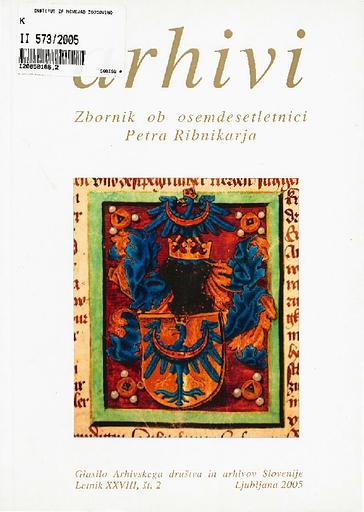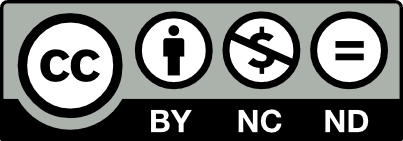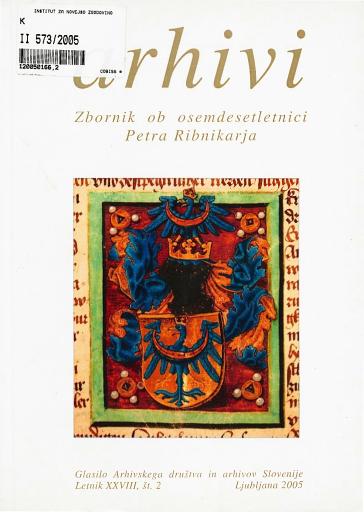/
Periodicals
/
Archives
The villages/places and municipalities as administrative territorial units 1945 -1955

Author(s):Janez Kopač
Co-author(s):Matevž Košir (ur.)
Year:2005
Publisher(s):Arhivsko društvo Slovenije, Ljubljana
Source(s):Arhivi, 2005, št. 2
Language(s):slovenščina
Type(s) of material:text
Keywords:upravnoteritorialna enota, kraj, občina, mesto, mestna občina, komuna, zakoni o ljudskih odborih, administrative territorial uni, place/village, municipality, town, town municipality, commune, laws concerning people's committees
Rights:

This work by Janez Kopač is licensed under Creative Commons Attribution-NonCommercial-NoDerivs 4.0 International
Files (1)

Name:ARHIVI_2005-2.pdf
Size:26.57MB
Format:application/pdf
Permanent link:https://hdl.handle.net/11686/file434
Description
As regarded the local level the end of World War Two meant the end of the administrative
territorial units (municipalities) which had existed till that time. The new authorities took over the
administrative territorial division of Slovenia that had been set forward and developed during the
war. At the lowest local level villages/places were put forward. In those local units the local public
authorities were taking an active part, while in larger places there existed town national liberation
committees as well, which were transformed into people's committees in February 1946. Both the
local public authorities and the town national liberation committees, as well as later the people's
committees, were put on the same level as regarded their competences. In the periodfrom 1952 on by
the side of the capital Ljubljana, there were five more towns (Celje, Maribor, Kranj, Jesenice and
Bled). In the spring of 1952 the villages/places were abolished and substituted by territorially larger
municipalities, three of them, from 1954 on only two towns and two kinds of town municipalities. This
form of administrative territorial division was abolished in the middle of 1955, when large
municipalities, called communes, were established. With some changes, they were maintained up to
the administrative territorial reform at the end of the year 1994.
Metadata (12)
- identifierhttps://hdl.handle.net/11686/9374
- title
- Kraji in občine kot upravnoteritorialne enote 1945-1955
- The villages/places and municipalities as administrative territorial units 1945 -1955
- creator
- Janez Kopač
- contributor
- Matevž Košir (ur.)
- subject
- upravnoteritorialna enota
- kraj
- občina
- mesto
- mestna občina
- komuna
- zakoni o ljudskih odborih
- administrative territorial uni
- place/village
- municipality
- town
- town municipality
- commune
- laws concerning people's committees
- description
- As regarded the local level the end of World War Two meant the end of the administrative territorial units (municipalities) which had existed till that time. The new authorities took over the administrative territorial division of Slovenia that had been set forward and developed during the war. At the lowest local level villages/places were put forward. In those local units the local public authorities were taking an active part, while in larger places there existed town national liberation committees as well, which were transformed into people's committees in February 1946. Both the local public authorities and the town national liberation committees, as well as later the people's committees, were put on the same level as regarded their competences. In the periodfrom 1952 on by the side of the capital Ljubljana, there were five more towns (Celje, Maribor, Kranj, Jesenice and Bled). In the spring of 1952 the villages/places were abolished and substituted by territorially larger municipalities, three of them, from 1954 on only two towns and two kinds of town municipalities. This form of administrative territorial division was abolished in the middle of 1955, when large municipalities, called communes, were established. With some changes, they were maintained up to the administrative territorial reform at the end of the year 1994.
- Konec druge svetovne vojne je na lokalni ravni pomenil tudi konec dotedanjih upravnoteritorialnih enot (občin). Nova oblast je povzela upravnoteritorialno delitev Slovenije, ki se je razvijala med vojno. Na najnižji lokalni ravni so se uveljavili kraji. V njih so kot lokalni organi oblasti delovali krajevni, v nekoliko večjih krajih tudi mestni narodnoosvobodilni, od februarja 1946 ljudski odbori, ki so bili po pristojnostih izenačeni. V obdobju do leta 1952 je poleg glavnega mesta Ljubljana delovalo še pet mest (Celje, Maribor, Kranj, Jesenice in Bled). Spomladi leta 1952 so bili kraji odpravljeni, nadomestile so jih večje občine, tri, od leta 1954 pa le še dve mesti in dve vrsti mestnih občin. Ta oblika upravnoteritorialne delitve je bila odpravljena sredi leta 1955, ko so bile ustanovljene velike občine, imenovane tudi komune. Z nekaterimi spremembami so se obdržale do upravnoteritorialne reforme konec leta 1994.
- publisher
- Arhivsko društvo Slovenije
- date
- 2005
- type
- besedilo
- language
- Slovenščina
- isPartOf
- rights
- license: ccByNcNd
Citirano v (1)
| Tipologija | Avtor(ji) | Naslov | Kraj | Založba | Leto |
|---|---|---|---|---|---|
| 2.01 Znanstvena monografija | Piškurić, Jelka | "Bili nekoč so lepi časi" : vsakdanjik v Ljubljani in okolici v času socializma | Ljubljana | Inštitut za novejšo zgodovino ; Študijski center za narodno spravo | 2019 |
